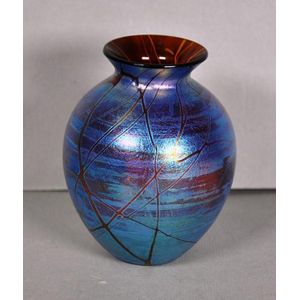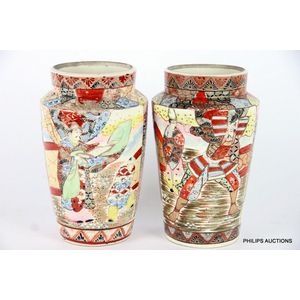Kyoto Satsuma Vases with Figural Panels and Gilding
You must be a subscriber, and be logged in to view price and dealer details.
Subscribe Now to view actual auction price for this item
When you subscribe, you have the option of setting the currency in which to display prices to $Au, $US, $NZ or Stg.
- Circa - A Latin term meaning 'about', often used in the antique trade to give an approximate date for the piece, usually considered to be five years on either side of the circa year. Thus, circa 1900 means the piece was made about 1900, probably between 1895 and 1905. The expression is sometimes abbreviated to c.1900.
- Gilding - Gilding is a method of ornamentation whereby a thin sheet of gold metal is applied to items made of wood, leather, ceramics, glass and silver for decorative purposes.
For furniture including mirrors, the sheet of gold is usually applied over a coating of gesso. Gesso is a mixture of plaster of Paris and gypsum mixed with water and then applied to the carved wooden frames of mirrors and picture frames as a base for applying the gold leaf. After numerous coats of gesso have been applied, allowed to dry and then sanded a coat of "bole", a usually red coloured mixture of clay and glue is brushed on and allowed to dry, after which the gold leaf is applied. Over time parts of the gilding will rub off so the base colour can be seen. In water gilding, this was generally a blue colour, while in oil gilding, the under layer was often yellow. In Victorian times, gilders frequently used red as a pigment beneath the gold leaf.
Metal was often gilded by a process known as fire gilding. Gold mixed with mercury was applied and heated, causing the mercury to evaporate, the long-term effect of which was to kill or disable the craftsman or woman from mercury poisoning. The pursuit of beauty has claimed many victims, not the least of which were the artists who made those pieces so highly sought after today.
This item has been included into following indexes:
- Japanese ceramics, factories and cities - Kyoto, Kyoyaki and Kyo-yaki wares 93
- Japanese ceramics, item types - other 2,592
-
Satsuma (Japan), item type
- figures and figurines 224
- other items 2,101
- vases 1,421
Visually similar items

Two Royal Worcester Sabrina ware 'Fish' decorated vases, circa 1926 and 1929, one signed W.H. Austin, stamped and incised Royal Worcester, Made in England, Sabrina Ware Porcelain numbered G932, tallest 20.5 cm high

15ct gold antique bangle set with an old cut diamond, 19.9 grams

Colin Heaney iridescent studio vase signed base, 11 cm high

A Chinese Nonya wear jacket, late Qing Dynasty, embroidered, woven and appliqued
